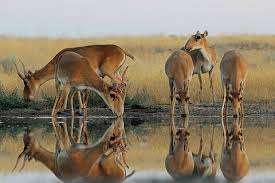Central Asian Mammals Initiative:

Representatives from a number of Central Asian countries have endorsed Central Asian Mammals Initiative that identifies priority transboundary conservation regions important for conserving seventeen iconic mammal species of the region.
- It was launched in 2014 at the 11th Meeting of the Conference of the Parties (COP11) to the Convention on the Conservation of Migratory Species of Wild Animals (CMS).
- It aims to reverse the population decline of 17 migratory mammal species in 14 Central Asian countries where these species live.
- CAMI presents a common framework to address major threats to the Central Asian migratory species.
- It currently covers 17 species including : Argali sheep, Asiatic cheetah, Asiatic wild ass, Bukhara deer, Eurasian lynx, gobi bear, goitered gazelle, kiang, Mongolian gazelle, Pallas’s cat, Persian leopard, Przewalski’s horse, saiga antelope, snow leopard, urial, wild camel, and wild yak.
The current Programme of Work (2021-2026) for CAMI initiative was adopted by CMS COP13.
Convention on the Conservation of Migratory Species:
- It is also known as the Bonn Convention, is an environmental treaty under the aegis of the United Nations Environment Programme.
- It provides a global platform for the conservation and sustainable use of migratory animals and their habitats.
- It was signed in Bonn, Germany, on 23 June 1979.
- It is the only global and UN-based intergovernmental organisation established exclusively for the conservation and management of terrestrial, aquatic and avian migratory species throughout their range.
- Activities by CMS Parties may range from legally binding treaties (called Agreements) to less formal instruments, such as Memoranda of Understanding.
- The Conference of Parties (COP) is the decision-making organ of this convention.




